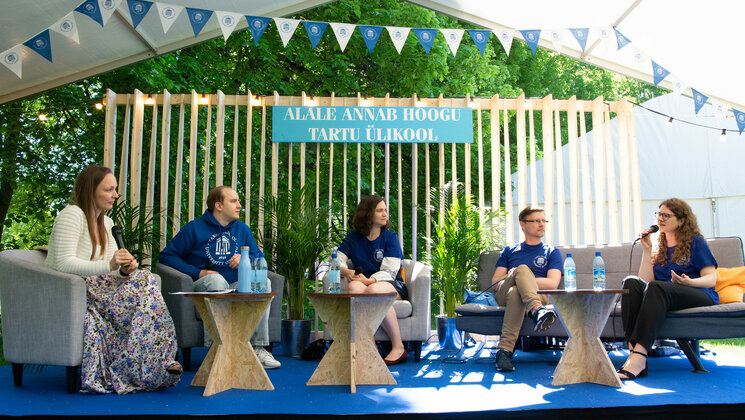-
Faculty of Arts and HumanitiesDean's Office, Faculty of Arts and HumanitiesJakobi 2, r 116-121 51005 Tartu linn, Tartu linn, Tartumaa EST0Institute of History and ArchaeologyJakobi 2 51005 Tartu linn, Tartu linn, Tartumaa EST0Institute of Estonian and General LinguisticsJakobi 2, IV korrus 51005 Tartu linn, Tartu linn, Tartumaa ESTInstitute of Philosophy and SemioticsJakobi 2, III korrus, ruumid 302-337 51005 Tartu linn, Tartu linn, Tartumaa EST0Institute of Cultural ResearchÜlikooli 16 51003 Tartu linn, Tartu linn, Tartumaa EST0Institute of Foreign Languages and CulturesLossi 3 51003 Tartu linn, Tartu linn, Tartumaa EST0School of Theology and Religious StudiesÜlikooli 18 50090 Tartu linn, Tartu linn, Tartumaa EST0Viljandi Culture AcademyPosti 1 71004 Viljandi linn, Viljandimaa EST0Professors emeritus, Faculty of Arts and Humanities0Associate Professors emeritus, Faculty of Arts and Humanities0Faculty of Social SciencesDean's Office, Faculty of Social SciencesLossi 36 51003 Tartu linn, Tartu linn, Tartumaa EST0Institute of EducationJakobi 5 51005 Tartu linn, Tartu linn, Tartumaa EST0Johan Skytte Institute of Political StudiesLossi 36, ruum 301 51003 Tartu linn, Tartu linn, Tartumaa EST0School of Economics and Business AdministrationNarva mnt 18 51009 Tartu linn, Tartu linn, Tartumaa EST0Institute of PsychologyNäituse 2 50409 Tartu linn, Tartu linn, Tartumaa EST0School of LawNäituse 20 - 324 50409 Tartu linn, Tartu linn, Tartumaa EST0Institute of Social StudiesLossi 36 51003 Tartu linn, Tartu linn, Tartumaa EST0Narva CollegeRaekoja plats 2 20307 Narva linn, Ida-Virumaa EST0Pärnu CollegeRingi 35 80012 Pärnu linn, Pärnu linn, Pärnumaa EST0Professors emeritus, Faculty of Social Sciences0associate Professors emeritus, Faculty of Social Sciences0Faculty of MedicineDean's Office, Faculty of MedicineRavila 19 50411 Tartu linn, Tartu linn, Tartumaa ESTInstitute of Biomedicine and Translational MedicineBiomeedikum, Ravila 19 50411 Tartu linn, Tartu linn, Tartumaa ESTInstitute of PharmacyNooruse 1 50411 Tartu linn, Tartu linn, Tartumaa ESTInstitute of DentistryL. Puusepa 1a 50406 Tartu linn, Tartu linn, Tartumaa ESTInstitute of Clinical MedicineL. Puusepa 8 50406 Tartu linn, Tartu linn, Tartumaa ESTInstitute of Family Medicine and Public HealthRavila 19 50411 Tartu linn, Tartu linn, Tartumaa ESTInstitute of Sport Sciences and PhysiotherapyUjula 4 51008 Tartu linn, Tartu linn, Tartumaa ESTprofessors emeritus, Faculty of Medicine0associate Professors emeritus, Faculty of Medicine0Faculty of Science and TechnologyDean's Office, Faculty of Science and TechnologyVanemuise 46 - 208 51003 Tartu linn, Tartu linn, Tartumaa ESTInstitute of Computer ScienceNarva mnt 18 51009 Tartu linn, Tartu linn, Tartumaa ESTInstitute of GenomicsRiia 23b/2 51010 Tartu linn, Tartu linn, Tartumaa ESTEstonian Marine Institute0Institute of PhysicsInstitute of ChemistryRavila 14a 50411 Tartu linn, Tartu linn, Tartumaa ESTInstitute of Mathematics and StatisticsNarva mnt 18 51009 Tartu linn, Tartu linn, Tartumaa EST0Institute of Molecular and Cell BiologyRiia 23, 23b - 134 51010 Tartu linn, Tartu linn, Tartumaa ESTTartu ObservatoryObservatooriumi 1 61602 Tõravere alevik, Nõo vald, Tartumaa EST0Institute of TechnologyNooruse 1 50411 Tartu linn, Tartu linn, Tartumaa ESTInstitute of Ecology and Earth SciencesJ. Liivi tn 2 50409 Tartu linn, Tartu linn, Tartumaa ESTprofessors emeritus, Faculty of Science and Technology0associate Professors emeritus, Faculty of Science and Technology0Area of Academic SecretaryHuman Resources OfficeUppsala 6, Lossi 36 51003 Tartu linn, Tartu linn, Tartumaa EST0Area of Head of FinanceFinance Office0Area of Director of AdministrationInformation Technology Office0Administrative OfficeÜlikooli 17 (III korrus) 51005 Tartu linn, Tartu linn, Tartumaa EST0Estates Office0Marketing and Communication OfficeÜlikooli 18, ruumid 102, 104, 209, 210 50090 Tartu linn, Tartu linn, Tartumaa EST0Area of RectorRector's Strategy OfficeInternal Audit OfficeArea of Vice Rector for Academic AffairsOffice of Academic AffairsUniversity of Tartu Youth AcademyUppsala 10 51003 Tartu linn, Tartu linn, Tartumaa ESTStudent Union OfficeÜlikooli 18b 51005 Tartu linn, Tartu linn, Tartumaa EST0Centre for Learning and TeachingArea of Vice Rector for ResearchUniversity of Tartu LibraryW. Struve 1 50091 Tartu linn, Tartu linn, Tartumaa ESTGrant OfficeArea of Vice Rector for DevelopmentCentre for Entrepreneurship and InnovationNarva mnt 18 51009 Tartu linn, Tartu linn, Tartumaa EST0University of Tartu Natural History Museum and Botanical GardenVanemuise 46 51003 Tartu linn, Tartu linn, Tartumaa EST0International Cooperation and Protocol Office0University of Tartu MuseumLossi 25 51003 Tartu linn, Tartu linn, Tartumaa EST0
Guided tours of the “Veil of Nature” take place every week
In response to the current environmental crisis, the exhibition “Veil of Nature” by Luxembourgish artist Justine Blau, curated by Fanny Weinquin, explores, through works navigating between documentation, illusion and narration, man’s relationship with nature and conservation practices. Guided tours of the exhibition “Veil of Nature” will take place every Saturday from June 22nd to July 20th and on the last day of the exhibition, July 28th.
Launched at the University of Tartu Botanical Garden on June 15th, the exhibition reflects the role of the botanical garden as a place of conservation and research, initiating an unusual dialogue between art and science. The starting point of this project was Justine Blau’s discovery of the Sicyos villosus, a now-extinct species of the gourd family, which Charles Darwin collected during his expedition on the Beagle in the 1830s. When Blau read that scientists hoped to recreate the plant using biotechnology and the herbarium specimen’s DNA, she explored what it meant to “bring species back to life”.
Photographs, videos, and sculptures stay alongside the plant realm, challenging it with their presence while blending into the environment. “The artworks question our perception of reality and feature different strategies established by men to overcome the limited temporality of human life in times of environmental crises”, said Fanny Weinquin, the exhibition’s curator.
Exhibition curator Fanny Weinquin will lead the curatorial tours in English, and artist and art teacher Eva Labotkin will lead guided tours in Estonian. On Wednesday, July 10th, from 11:00 AM to 12:15 PM, a soap bubbles workshop for children aged 6-11 related to the exhibition will be held.
Guided tours and curatorial visits take place on:
- Saturday, June 22nd, Eva Labotkin, guided tour in Estonian, 11:00-12:00;
- Saturday, June 29th, Eva Labotkin, guided tour in Estonian, 11:00-12:00;
- Saturday, July 6th, Fanny Weinquin, curatorial tour in English, 11:00-12:00;
- Saturday, July 13th, Eva Labotkin, guided tour in Estonian, 11:00-12:00;
- Saturday, July 20th, Eva Labotkin, guided tour in Estonian, 11:00-12:00;
- Sunday, July 28th, Fanny Weinquin, curatorial tour in English, 14:00-15:00.
“During the curatorial tour, I will give an insight into the conceptualization and preparation process of the exhibition. Starting from the gallery to the greenhouses, I will guide the visitors through the organic walk as we have imagined it. It was not easy to create a well-balanced interaction with the botanical garden, so powerful is the vigorous plant kingdom that inhabits the place”, Weinquin explained.
The show examines some nature-culture interplays and dilemmas with works involving magic tricks, preserved soap bubbles and compositions grown from salt crystals. The artist visited several herbaria and seed banks in Europe for the exhibition and reflected on her experiences during the exhibition making. Visitors can read real and fictional descriptions from the Galápagos Islands, where Darwin partly sketched out his theory of evolution. Visitors to the exhibition will be able to reflect on the roots of natural history, science as a practice, an outlook on the world, and concerns about biodiversity and extinction.
The exhibition “Veil of Nature” is part of the Arts of Survival Creative Nature Festival and belongs to the main programme of the European Capital of Culture Tartu 2024. It is open at the University of Tartu Botanical Garden from June 15th to July 28th. The exhibition can be visited during the opening hours of the Botanical Garden every day from 10:00 to 17:00. A greenhouse ticket is required to visit the exhibition and participate in the guided tour.
The exhibition is supported by Kultur | lx - Luxembourg Arts Council, the Ministry of Culture/Luxembourg Government, the City of Tartu, and the Cultural Endowment of Estonia.
Guided tours of the “Veil of Nature”

Learner of Estonian as a second language: we cannot learn without you

University of Tartu Museum opens ‘Lifesaver’ installation on Toomemägi


